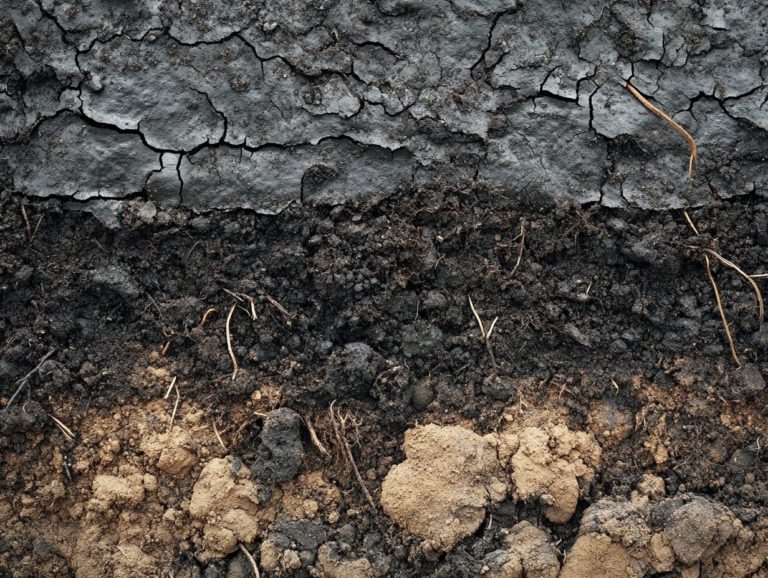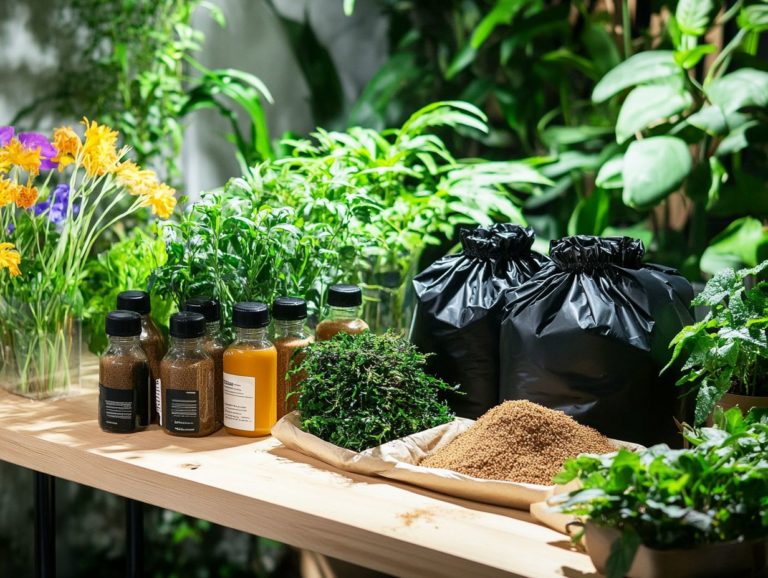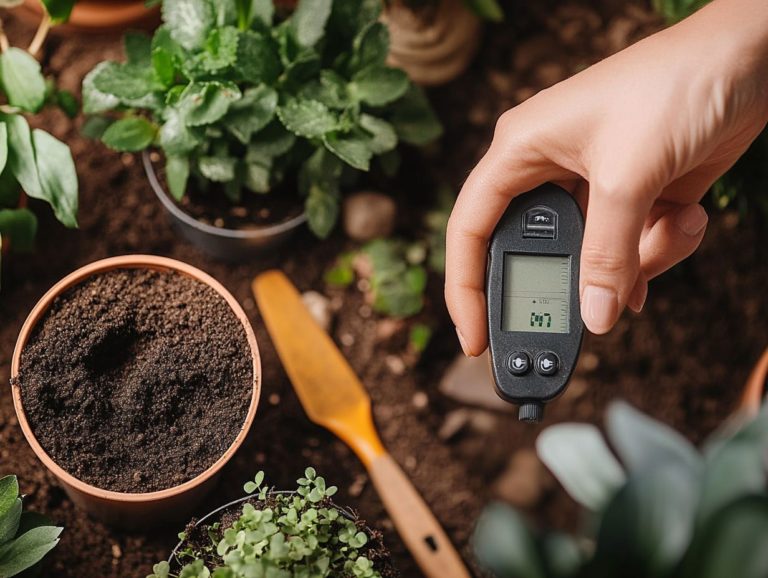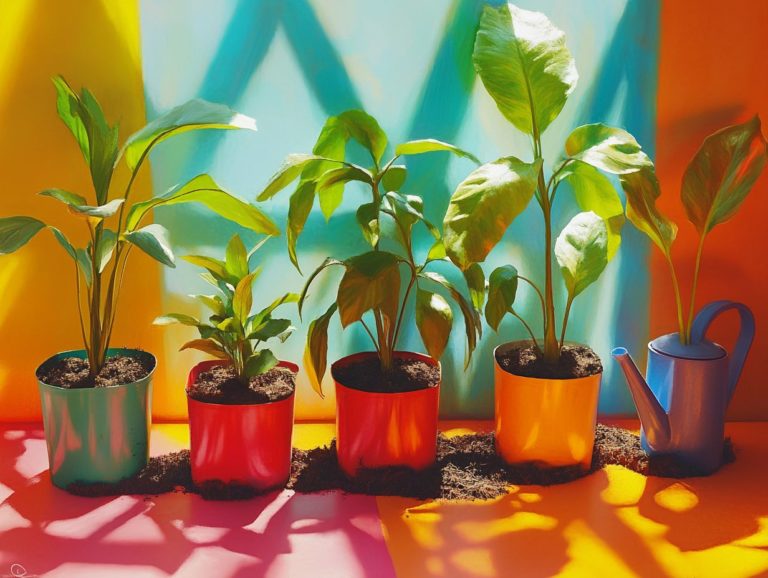Top Indoor Plants That Thrive in Poor Soil
Indoor gardening can often seem like a daunting task, particularly when you’re faced with less-than-ideal soil conditions.
Fortunately, there are resilient plants that can thrive even in challenging soil, bringing beauty and life to your space without demanding extensive care.
Take the opportunity to explore 15 top indoor plants, from the low-maintenance Snake Plant to the elegant Peace Lily, which not only survive but truly flourish in tough environments.
You’ll uncover their unique benefits, discover care tips, and learn how to assess your soil, all designed to help you cultivate a vibrant indoor garden with effortless ease.
Contents
- Key Takeaways:
- 1. Snake Plant
- 2. Jade Plant
- 3. Aloe Vera
- 4. Spider Plant
- 5. ZZ Plant
- 6. Peace Lily
- 7. Pothos
- 8. Chinese Evergreen
- 9. Dracaena
- 10. Philodendron
- 11. English Ivy
- 12. Peperomia
- 13. Cast Iron Plant
- 14. Bromeliads
- 15. Prayer Plant
- What Makes These Plants Ideal for Poor Soil Conditions?
- Frequently Asked Questions
- What Are the Top Indoor Plants That Thrive in Poor Soil?
- What Makes These Plants Suitable for Poor Soil Conditions?
- Do These Plants Require Any Special Care or Maintenance?
- Can These Plants Be Grown in Pots or Containers?
- Which of These Plants Are Suitable for Low-Light Conditions?
- Are These Plants Safe for Pets and Children?
Key Takeaways:
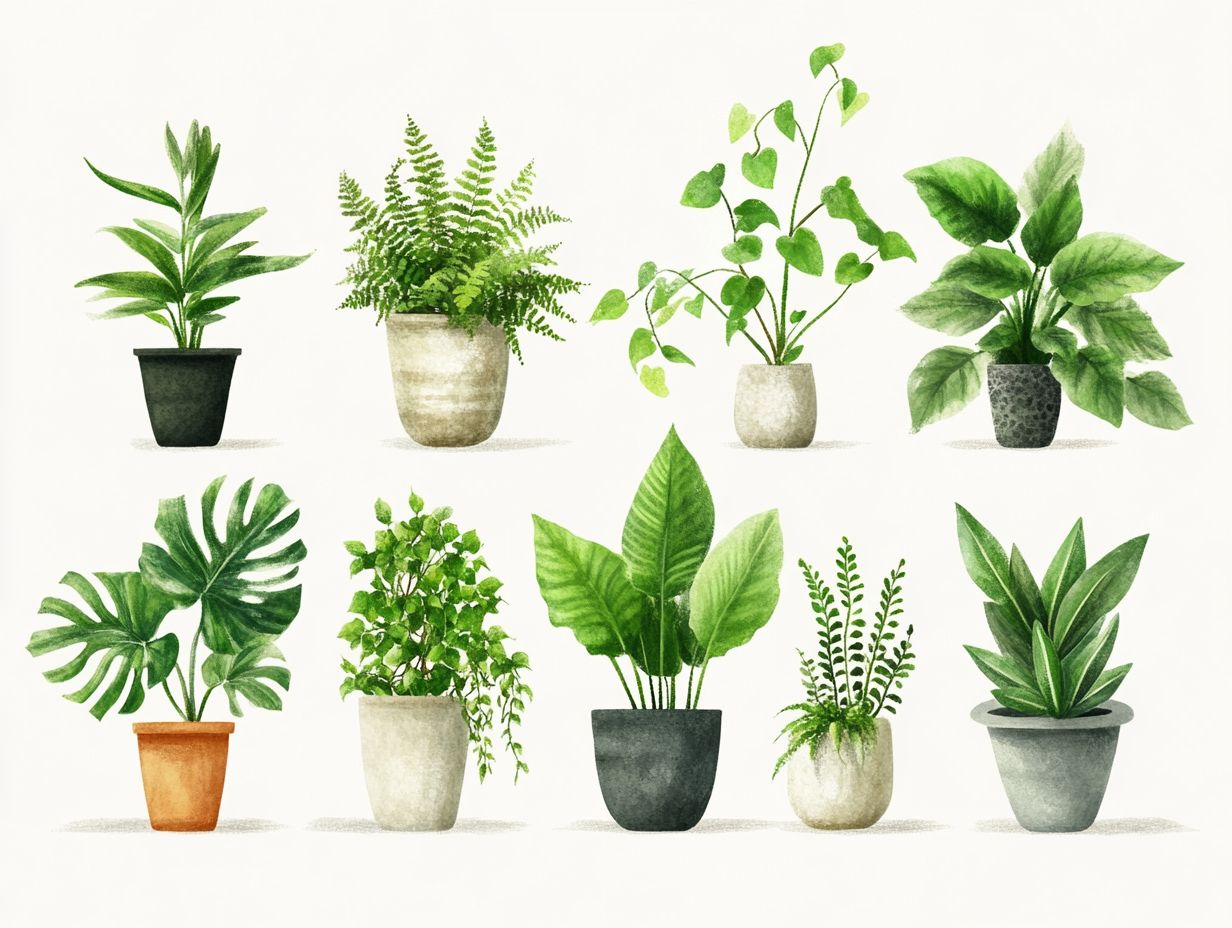
- Snake Plant, Jade Plant, and Aloe Vera thrive in poor soil conditions, making them perfect for less-than-ideal growing environments.
- Indoor plants not only add aesthetic value to a room but also improve air quality, reduce stress, and boost mood and productivity.
- To determine if your soil is poor, look for signs such as slow plant growth, yellowing leaves, and dry, crumbly soil. Testing the soil’s pH and nutrient levels is also helpful.
- To care for these plants in poor soil, ensure adequate drainage, use well-balanced fertilizer, and regularly check the soil’s moisture level. Consider repotting or adding organic matter to improve soil quality.
- These plants adapt to various growing conditions. Research specific needs for each plant and adjust care as necessary.
1. Snake Plant
The Snake Plant, or Sansevieria, is a tough houseplant. It thrives in many conditions and helps purify your indoor air.
It s a stunning addition to any indoor space. Whether you place it in bright, indirect light or a cozy, low-light corner, this plant showcases its versatility and fondness for humidity.
Its ability to filter out toxins and produce oxygen especially at night adds to its appeal for health-conscious indoor gardeners. You’ll love how easy it is to care for this plant! It needs only occasional watering and a quick wipe down of its glossy leaves to keep them dust-free.
This low-maintenance nature allows it to blend seamlessly with a variety of indoor plants, complementing them beautifully while standing out with its striking upright leaves.
Whether you re a seasoned plant enthusiast or just starting your indoor gardening journey, incorporating this hardy plant can elevate both your space and your well-being.
2. Jade Plant
The Jade Plant, or Crassula ovata, is a delightful succulent known for its lush, oval leaves and its association with good luck and prosperity. It s a stunning addition to any indoor garden.
To keep this charming plant thriving, proper care is key. It flourishes best in indirect light; direct sunlight can scorch those delicate leaves. Use soil that allows water to flow out easily to prevent overwatering.
Typically, you should water it every two to three weeks, ensuring the soil dries out completely between waterings.
The Jade Plant also carries financial significance in Feng Shui. It s believed to attract wealth and abundance, infusing your living space with positive energy.
3. Aloe Vera
Aloe Vera isn t just a beautiful succulent; it s a true gem known for its soothing gel, making it an exceptional addition to your skincare and health routine while purifying the air in your home.
This plant is easy to care for. It thrives in bright, indirect light, making it great for everyone from beginners to pros. Its gel can hydrate your skin, reduce inflammation, and even aid in healing minor wounds, offering a natural remedy that many incorporate into their daily routines.
Aloe Vera also purifies the air, enhancing your overall well-being by filtering out toxins. Whether it graces your windowsill or becomes a staple in your skincare regimen, this versatile succulent provides countless benefits without requiring much attention.
4. Spider Plant
The Spider Plant, with its striking green and white striped leaves, is a top pick for indoor gardeners. Its rapid growth and impressive ability to purify air make it an exceptional choice for enhancing indoor air quality.
To keep this plant thriving, you need to understand its care requirements. It flourishes in bright, indirect light but can also manage in lower lighting conditions without too much fuss. Regular watering is crucial, but remember to let the soil dry out slightly between waterings to avoid root rot, a condition that occurs when roots sit in water for too long and start to decay.
One fascinating aspect of the Spider Plant is its propagation method. This involves growing new plants from cuttings, often called ‘babies.’ These small offshoots spring from the parent plant and can be easily rooted in soil or water. Transform your space instantly with this resilient plant that doesn’t just look good it cleans your air too!
5. ZZ Plant
The ZZ Plant, scientifically known as Zamioculcas zamiifolia, is a remarkably resilient houseplant. It thrives even in low-light conditions, making it perfect for anyone new to plant care or seeking a low-maintenance option.
Its adaptability to indirect light lets it thrive in dimly lit rooms, so there s no need to fret about finding the perfect sunny spot. With minimal watering requirements only needing a drink every few weeks it fits seamlessly into even the busiest of lifestyles.
Beyond its ease of care, the ZZ Plant doubles as a natural air purifier and effortlessly adds a dash of greenery to your space. Its sleek, glossy leaves enhance various home styles, from modern to traditional, making it a versatile addition to any interior decor.
6. Peace Lily
The Peace Lily, or Spathiphyllum, is a true gem. It is admired not just for its graceful white blooms but also for its exceptional air-purifying qualities, making it a stunning addition to any indoor space.
To ensure this beautiful plant flourishes, provide it with indirect sunlight; too much direct light can scorch those exquisite leaves. Water it when the top inch of soil feels dry, typically around once a week. Keep an eye on its condition so you can adjust your watering schedule as needed.
While the Peace Lily is a favorite among plant enthusiasts, remember that it can be toxic to cats if ingested. Positioning it in areas out of reach of curious pets is a wise gardening strategy.
7. Pothos

Golden Pothos is the quintessential houseplant you ve been searching for. It’s celebrated for its vigorous growth and stunning trailing vines. You ll love how this hardy companion fits right into your life, thriving beautifully in indirect light.
This plant adapts effortlessly to low light conditions and flourishes with minimal maintenance. While it appreciates regular watering and the occasional dose of fertilizer, it’s forgiving if you forget. Not only is it a feast for the eyes, but it also purifies the air, helping to eliminate toxins and enhance your indoor air quality. To ensure it thrives, understanding why soil quality matters for indoor plants is essential.
If you’re considering propagation, simply snip a healthy vine and place it in water until roots emerge an easy and gratifying project. With its lush foliage, this plant has a remarkable ability to transform dull corners of your home into vibrant, refreshing havens.
8. Chinese Evergreen
The Chinese Evergreen, or Aglaonema, is a truly stunning houseplant that showcases vibrant foliage. It thrives in humidity, making it an excellent choice for infusing color and life into your indoor space.
This adaptable beauty flourishes in moderate to bright indirect light, yet it s surprisingly tolerant of lower light conditions. You can place it in various spots, from dim corners to sunny windowsills, and it will still thrive.
Its love for higher humidity levels makes it perfectly suited for bathrooms or kitchens, where moisture is abundant. Beyond its visual charm, the Chinese Evergreen is celebrated for its air-purifying properties, effectively filtering toxins from the air to promote a healthier living environment.
Its resilience and ease of care make it a favorite among both novice and seasoned plant enthusiasts alike.
9. Dracaena
Dracaena is a captivating genus of houseplants. It not only elevates your home decor but also cleans the air, making it a top choice for plant lovers.
With a variety of species, such as Dracaena marginata with its sword-like leaves and Dracaena fragrans known for its cornstalk appearance, these plants add unique beauty to your space.
They typically thrive in indirect light and have minimal watering needs. This makes them perfect for your busy lifestyle.
Dracaena plants also clean the air, enhancing indoor air quality and creating a healthier living environment for you and your loved ones.
10. Philodendron
Philodendrons, including devil’s ivy, are popular houseplants. They are loved for their lush foliage and ability to adapt to indirect light.
However, remember that these lovely plants can be toxic to cats if ingested. You’ll find various types of philodendrons, such as the heartleaf philodendron and the philodendron bipinnatifidum, each with unique leaf shapes.
To keep these vibrant plants thriving, provide the right amount of water. Aim for moist soil, but avoid sogginess. If you have pets, position your philodendrons out of reach to create a safe environment.
Beyond their beauty, these plants filter out toxins, making them a superb choice for homeowners who care about air quality.
11. English Ivy
English Ivy is a versatile climbing plant. You ll love its elegant, trailing vines and ability to clean the air, making it perfect for both indoor and outdoor gardens.
This plant prefers bright, indirect sunlight but adapts to lower light with slower growth. Keep the soil consistently moist without waterlogging to prevent root rot.
If you’re considering propagation, creating new plants from cuttings is simple. Just place them in water or moist soil.
English Ivy looks stunning in hanging baskets or as ground cover. It enhances your living space by filtering airborne toxins while adding to your home s beauty.
12. Peperomia
Peperomia is a delightful houseplant that brings charm to your indoor garden. It thrives in indirect light and loves high humidity.
This captivating plant family features many species with diverse leaf patterns and colors. Examples include the glossy green Peperomia obtusifolia and the wrinkled Peperomia caperata.
Caring for Peperomia is easy. They thrive in well-draining soil and prefer to be watered sparingly, letting the soil dry out between watering sessions.
By filtering indoor pollutants, Peperomia not only enhances your space’s beauty but also fosters a healthier living environment.
13. Cast Iron Plant
The Cast Iron Plant, or Aspidistra, is a tough little plant that thrives in low light. Perfect for busy folks who still want greenery at home, it can survive in poor soil conditions.
You ll appreciate that the Cast Iron Plant requires minimal watering, happily drying out between sessions. It flourishes in various light conditions from shadowy corners to brighter spots.
Its impressive air-purifying qualities enhance your indoor environment by filtering out toxins, contributing to a healthier living space. Don’t miss out on adding this striking plant to your collection!
With very little maintenance required, the Cast Iron Plant effortlessly blends into homes and offices alike, making it a favorite for those who love greenery without the added fuss.
14. Bromeliads
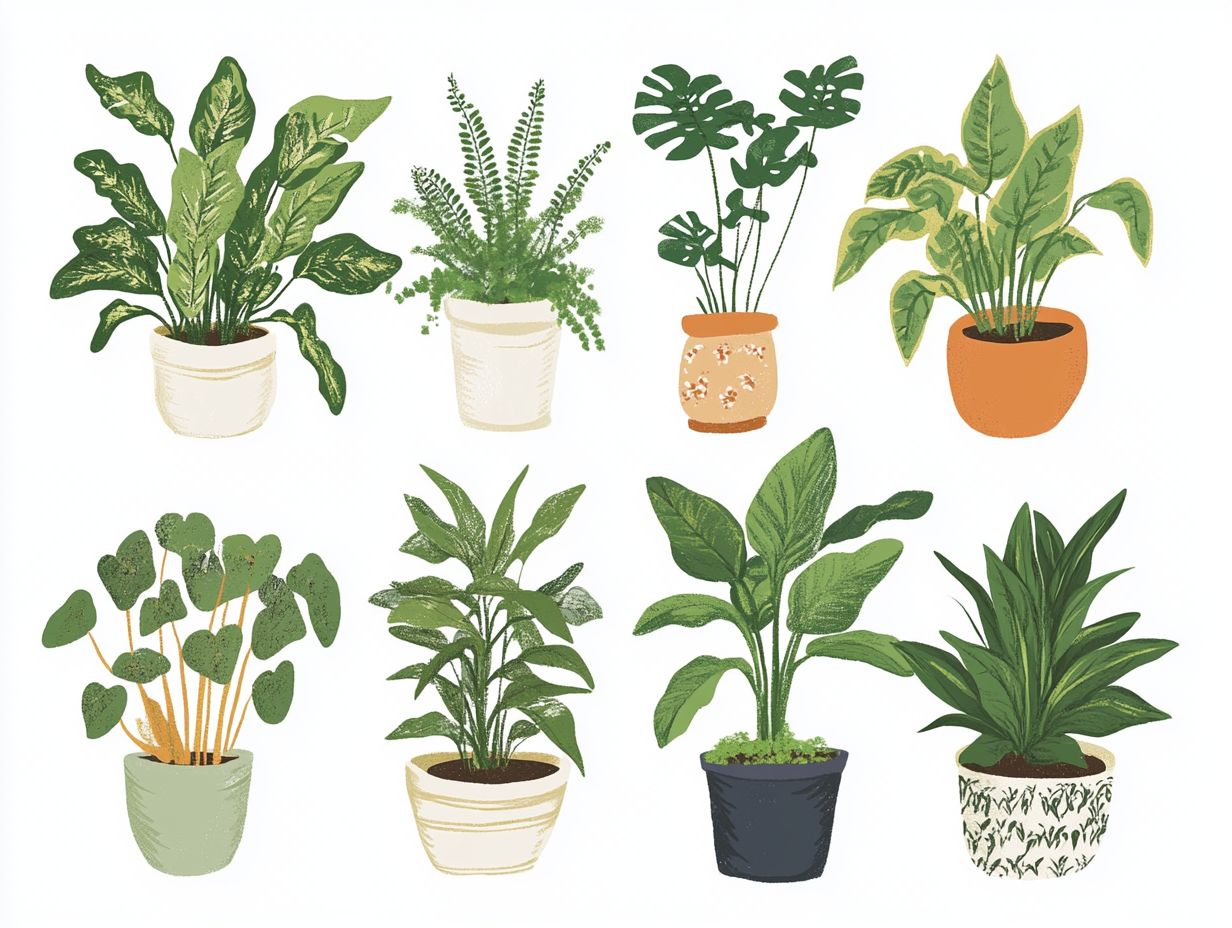
Bromeliads are stunning plants that thrive in humid environments, making them a remarkable choice for your home or office. They provide that exotic flair many indoor gardeners seek.
These captivating plants flourish in bright, indirect light, effortlessly infusing any space with a tropical vibe. Their colorful blooms, adorned with bold colors and intricate shapes, act as living art, enhancing the aesthetic appeal of your interiors.
In terms of care, ensuring adequate humidity levels ideally between 50% to 70% is crucial. This easy-going plant is perfect for those who wish to blend elegance with simplicity in indoor gardening, transforming any corner into a vibrant oasis.
15. Prayer Plant
The Prayer Plant, with its captivating leaf patterns, is an exquisite addition to any indoor space that thrives on humidity. Consider adding it alongside a fiddle leaf fig for extra visual interest.
To ensure this vibrant beauty flourishes, you’ll need to provide consistent care regarding light and moisture. It prefers bright, indirect sunlight, so keep it away from harsh, direct rays that could scorch its stunning foliage.
Regular watering is essential, ensuring the soil remains consistently moist but not soggy. Let the top inch dry out between waterings to strike the perfect balance.
The Prayer Plant thrives in humid environments, so misting or using a humidity tray to replicate its natural habitat will work wonders. With its distinct leaf patterns truly a work of art this plant can elevate the aesthetic of any room, making it a prized choice among plant enthusiasts.
What Makes These Plants Ideal for Poor Soil Conditions?
Many indoor plants, such as the resilient Snake Plant and ZZ Plant, are perfect for poor soil conditions. These plants thrive where others often struggle, thanks to their adaptable nature and a watering schedule that conserves resources. These amazing plants have special features that enable them to extract essential nutrients even from nutrient-depleted soils. Choose hardy and resilient species for success in cultivating greenery in less-than-ideal conditions.
Focus on plants that feature:
- Thick, fleshy leaves
- Deep root systems, which can store water efficiently
To ensure proper drainage, opt for pots with holes and add a layer of gravel at the bottom to enhance plant health. Regularly monitoring soil moisture levels will also help you maintain optimal growing conditions, setting you up for success in your indoor gardening endeavors. For the best results, consider using top soil amendments for healthy indoor plants. Incorporating fast-growing shoots of other plants can help create a vibrant environment.
What Are the Benefits of Having Indoor Plants?
Having indoor plants offers a wealth of benefits that transform your space into a sanctuary. They purify the air, elevate aesthetics, and contribute to your overall well-being, making them a stunning addition to any environment, including flowering houseplants.
The presence of greenery indoors can work wonders for your mental health. Just the simple act of nurturing these plants fosters a sense of purpose while alleviating feelings of stress and anxiety. Various species, including flowering plants such as bee balm or butterfly weed, are adept at absorbing harmful pollutants, naturally enhancing air quality and cultivating a healthier atmosphere for everyone in your home. The calming visuals and gentle fragrances of indoor plants create a serene ambiance, turning any room into a tranquil oasis.
Incorporating these plants into your life may boost your mood and surge your productivity, all while basking in a calm and peaceful setting. Don t wait! Start improving your indoor garden today for a healthier home.
How Can One Determine If Their Soil Is Poor?
Determining whether your soil is lacking involves observing several key indicators, such as drainage issues and the health of your plants both of which can impact the resilience of your indoor greenery. To check soil quality, utilize tools like pH testing kits that measure soil acidity and soil moisture meters. Signs like compacted soil or a noticeable absence of earthworms can signal underlying problems that demand your immediate attention. It’s essential to address these poor conditions, as they stifle plant growth and increase vulnerability to diseases and pests. Consider planting golden pothos or spider plants for added strength.
By taking proactive measures like amending the soil with organic matter or using cover crops you can significantly boost the vitality of your indoor garden.
What Are Some Tips for Caring for These Plants in Poor Soil?
Caring for plants in less-than-ideal soil conditions requires a strategic approach. Focus on improving soil quality, adjusting your watering schedule, and selecting resilient houseplants like parlor palms and asparagus ferns that can thrive despite the challenges.
One effective method for enhancing soil quality is to incorporate organic matter. This includes things like compost, which is decomposed plant and animal material that enriches soil, or well-rotted manure. These additions provide essential nutrients, improve drainage, and create a hospitable environment for your plants. Consider adding New England aster for a splash of color.
When it comes to watering, remember that plants in poor soil need deep watering but less often. This encourages strong root growth.
For plant selection, choose native or drought-tolerant species. These plants are typically well-suited to thrive in tough conditions, leading to better outcomes.
You can easily turn your challenging garden into a vibrant space by combining soil improvements, tailored watering techniques, and suitable plant choices.
Can These Plants Thrive in Other Growing Conditions?
Many of these resilient houseplants can adapt beautifully to various growing conditions, not just poor soil. They flourish in differing light levels and humidity, making them great choices for various indoor environments.
Take the snake plant, for example. It can endure low-light situations while also thriving in brighter settings. The peace lily dazzles with its stunning white blooms and adapts effortlessly to moderate light and higher humidity. To learn more about ideal plants for your home, check out our guide on top indoor plants for beginners and their soil needs. It often thrives in spaces like bathrooms or kitchens.
Pothos plants are another fantastic option. They exhibit incredible versatility, growing well in low light and tolerating a bit of neglect, which is perfect for busy lifestyles. Understanding these adaptations is crucial for maximizing your plants’ health and enhancing your home s aesthetics.
Frequently Asked Questions
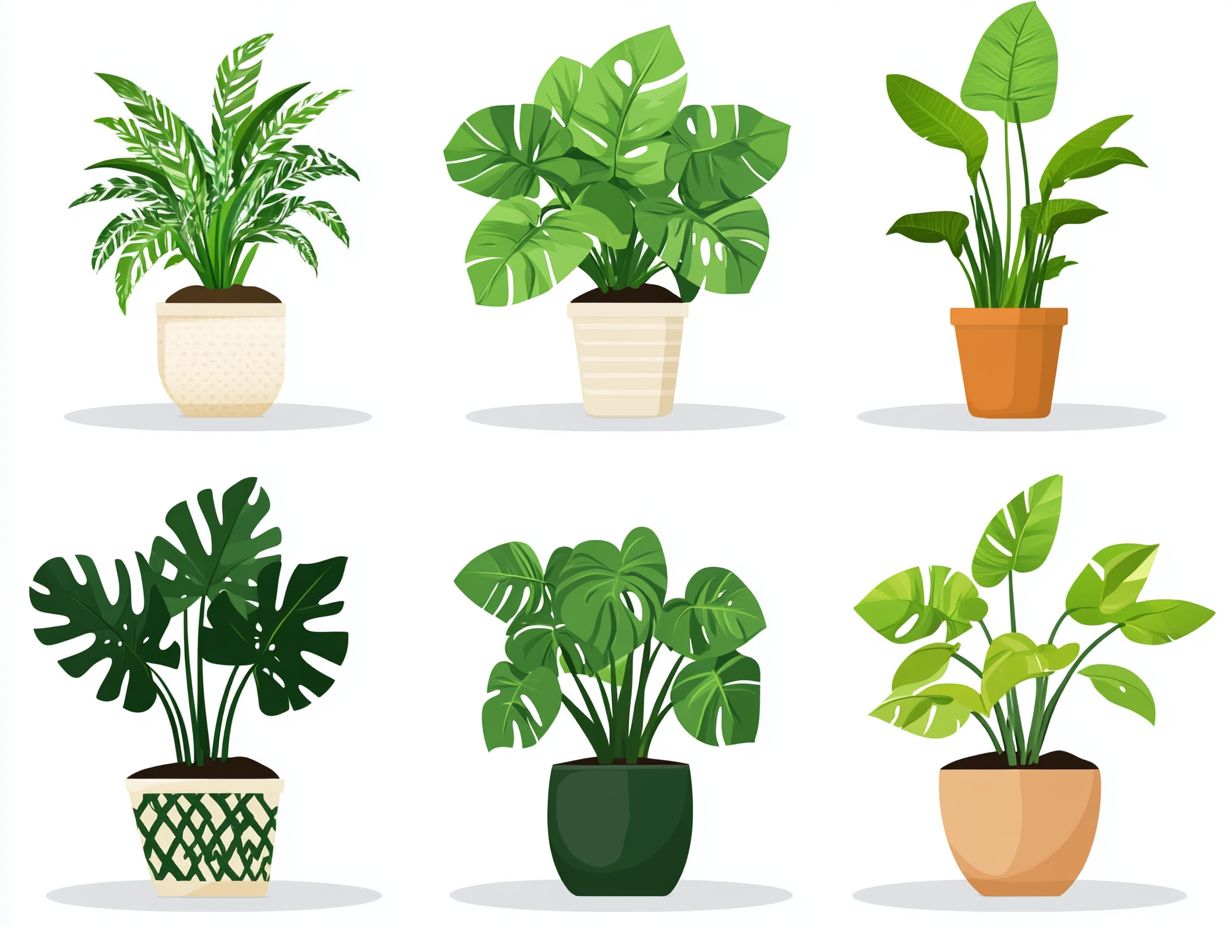
What Are the Top Indoor Plants That Thrive in Poor Soil?
Some of the top indoor plants that thrive in poor soil include snake plants, ZZ plants, spider plants, pothos, cacti, and succulents.
What Makes These Plants Suitable for Poor Soil Conditions?
These plants have adapted to survive in low-nutrient environments, making them perfect for growing in poor soil. They also have shallow root systems that do not require deep or rich soil.
Do These Plants Require Any Special Care or Maintenance?
No, these plants do not require special care or maintenance. However, it’s essential to avoid over-watering them and to provide adequate sunlight for their growth.
Can These Plants Be Grown in Pots or Containers?
Yes, these plants can thrive in pots or containers as long as they have proper drainage and are not over-watered. Repotting them once a year is also recommended to refresh the soil and provide nutrients.
Which of These Plants Are Suitable for Low-Light Conditions?
Snake plants, ZZ plants, and pothos are all suitable for low-light conditions. They can thrive in areas with little to no natural light, making them perfect for indoor spaces.
Are These Plants Safe for Pets and Children?
While these plants are generally considered safe, it s best to research and double-check before bringing them into a home with pets or children. Some plants may have toxic properties that could be harmful if ingested.

